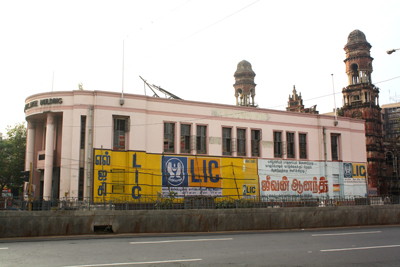|
Even as the first barricades have been put up cordoning off parts of Mount Road to facilitate work to execute the Metro Rail project, the fate of several heritage structures and precincts is causing concern. A mammoth project of this nature requires vast amounts of space for tracks, stations and depots. It is reliably learnt that the areas the authorities are eyeing for this purpose will put heritage buildings and precincts under threat.
The powers-that-be, in eyeing these buildings, would appear to be deliberately avoiding any clash with the High Court of Madras by looking at buildings and precincts NOT listed in the Justice Padmanabhan Committee report which formed the basis of a judgement that ordered protection to all structures and properties enumerated in that document. Advantage is also being taken of certain ambiguities in the wordings of the same report.
 When organisations that should know better desecrate their own buildings with wall paintings like this, what price heritage or a Singara Chennai with taste?! – (Photograph: Vignesh Suresh Bhimsingh.) |
Take for instance the Poultry Research Farm* of the Government that stands in the heart of the city, in the Nandanam area. This has for long been a habitat of free-ranging deer and the city has the distinction of being the only metropolis in the country to have these animals within its perimeter. The animals were once found in plenty in Velachery, Taramani and the IIT campus. But with rapid construction of housing and offices, the deer population in the first two areas has dwindled. Now Nandanam and IIT together boast of around 900 deer and the scrubland and jungle in Nandanam have been ideal breeding ground for the animals. Government has now decided to hand over this area to the Metro authorities to build their headquarters. The Poultry Farm has been shifted to Madhavaram, but shifting the deer is impossible as this species does not adapt itself to new environments and, invariably, dies of anxiety and shock. It is also open to debate as to whether a green lung in the city needs to be sacrificed for a concrete block. Surely the Metro can have its headquarters in outlying suburbs. After all, it is meant to facilitate travel from the outskirts to the heart of the city.
The above precinct is not covered in the Padmanabhan Committee report mainly because the document was not meant to be a survey of heritage buildings and sites to be protected but a listing of structures and premises that because of their importance, ought not to be hidden behind large outdoor advertising panels. It was a readily available document when the Court had to decide on the fate of some heritage buildings facing demolition in the city and it has now become a basic listing. It must be remembered that it is by no means comprehensive and the Court has itself recommended the setting up of a Heritage Conservation Committee that will add further properties to the list. And work on this additional listing is underway even as these lines are written.
Another area under threat is where the Government stationery depot stands, behind the Poompuhar premises. The Metro Rail’s Mount Road station is planned to be located here. The ornate building is listed in the Padmanabhan report but the authorities are taking cover behind the fact that the document mentions only the showroom and not the entire premises. They are arguing that the rear of the structure is not protected by the Court ruling and can therefore be given to Metro-Rail. What is not being looked at is the impact of vibrations during the construction of the station and the subsequent operation of the rail service. These can damage not only the Poompuhar building but also its neighbour, Higginbotham’s, another listed building. It is worthwhile pointing out here that the National Monuments Authority stipulates a 300 m radius around heritage structures within which no new construction can be planned. Of course, in the absence of a Heritage Act in the State, the above buildings cannot hope to be covered under such laws, but these can still be considered guidelines when permission is given – or withheld – for demolition.
The Metro-Rail has also planned its route along Poonamallee High Road in such a fashion that it cuts right below the land that belongs to St. Andrew’s Kirk. The building is unique for its terracotta well foundations and it is open to doubt as to whether these can withstand the strain of co-existing with a rail-network. The matter has been represented to the Government by the parishioners of the Kirk, but no response has been received.
All these are matters for the Heritage Conservation Committee appointed by the CMDA to take up with the Government and the Metro-Rail authorities. It is to be hoped that the HCC will do just that and, in the process, press for the immediate passing of a Heritage Act (already promised by a Minister of the Government) which will protect all such endangered properties and premises.
Stop Press: *Poultry Research Farm belongs to the Tamil Nadu Veterinary and Animal Sciences University. The decision to hand the land over to Metro-Rail has been contested by a Public Interest Litigation file in court on December 29th, after our correspondent wrote this report.
|